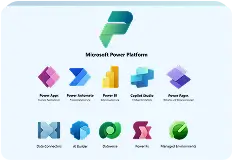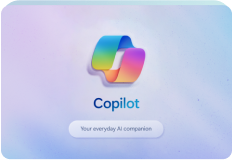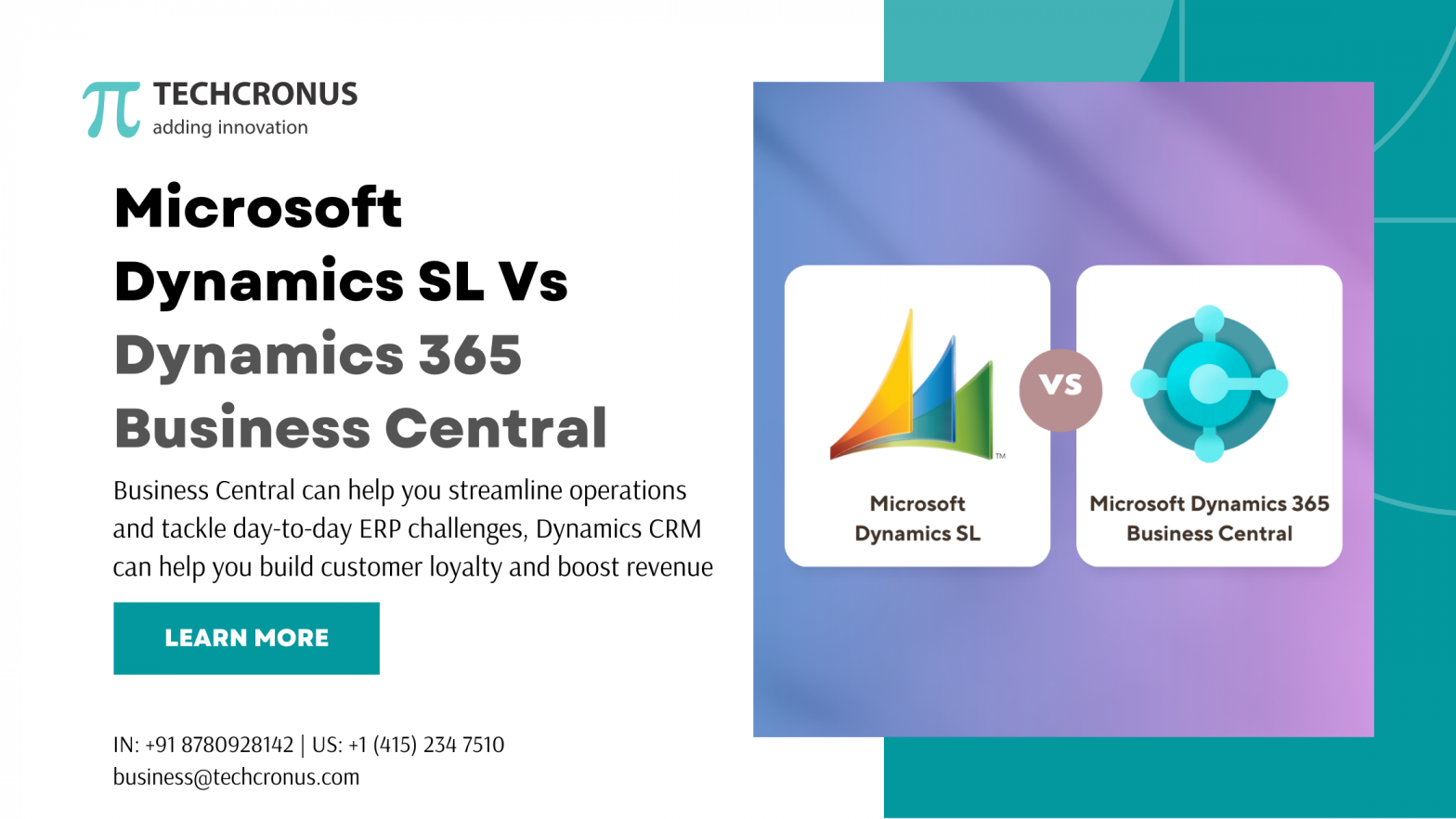Table of Contents
Difference Between Microsoft Dynamics SL and Dynamics 365 Business Central
Finalizing an enterprise resource planning (ERP) software can be challenging, particularly given the array of options available in the market. In this article, we will examine two prominent offerings from Microsoft Dynamics 365 Business Central Solutions:
- Microsoft Dynamics SL
- Microsoft Dynamics 365 Business Central
Microsoft Dynamics SL is tailored primarily for project-driven organizations, providing comprehensive financial and project management functionalities. However, with its impending end-of-life announcement, many businesses are actively exploring alternatives.
Dynamics 365 Business Central is a cloud-based ERP solution designed for enterprises of all sizes. It offers a comprehensive suite of features, including:
- Financial Management
- Sales and Service Management
- Supply Chain Management
- Project Management
- Operations Management
Business Central provides a modern, scalable, and cost-effective solution for businesses. Delve deeper into the intricacies and advantages of transitioning from Dynamics SL to Business Central. Explore the critical distinctions that can enhance your business and position it for long-term success.
What Is Microsoft Dynamics SL Software?
Microsoft Dynamics SL is an enterprise resource planning (ERP) software designed for project-driven small to midsize businesses (SMBs). It was originally developed by Solomon Software and acquired by Microsoft in 2000. With nearly 40 years of existence, Microsoft Dynamics SL has maintained competitiveness through regular updates, advanced features, and customization options. It facilitates efficient management of financials, projects, and resources. However, it’s important to note that Microsoft has announced the end-of-life date for extended support of Microsoft Dynamics SL, with mainstream support ending in January 2024.
What Is Dynamics 365 Business Central?
Microsoft Dynamics 365 Business Central, formerly known as Dynamics NAV, is a cloud-based ERP solution that optimizes business processes for small to medium-sized enterprises (SMEs). This application operates as a cloud-based Software as a Service (SaaS), allowing users to access it from any location at any time.
Business Central caters to businesses of varying sizes, facilitating the management of finance, purchasing, inventory, supply chain, customer relationships, and operational streamlining. It seamlessly integrates with other Microsoft products such as Office 365, Microsoft Power BI, and Microsoft Teams.
As a contemporary ERP system, Business Central by Microsoft offers scalability and accessibility, enabling businesses to adapt and expand efficiently. It provides a comprehensive view of business operations, delivering real-time insights into every aspect of operations. With an interactive and responsive interface, Microsoft Business Central empowers users to make informed decisions and collaborate effectively with others.
Why Upgrade from Dynamics SL to Business Central?
Upgrading from Dynamics SL to Business Central presents several compelling reasons due to the prevalent challenges associated with sticking to Dynamics SL. These challenges include limited reporting functionalities, fragmented data leading to inefficiencies, manual processes, and a lack of real-time insights. Additionally, businesses face:
- Complexities in data analysis
- Heavy reliance on IT for reporting tasks
- Restricted visualization options
- Inability to incorporate multiple data sources
Addressing these issues is crucial for organizations aiming to optimize their operations and leverage the full potential of their ERP system. By transitioning to Dynamics 365 BC, businesses can overcome these challenges and adopt a streamlined, efficient, and data-driven approach to managing their operations and decision-making processes.
Microsoft Dynamics SL vs Dynamics 365 Business Central
SL and Business Central differ in various aspects including functionality, deployment, scalability, cost, and more. Let’s explore the key factors that set these two solutions apart:
1. Target Audience:
- Microsoft Dynamics SL: Primarily serves project-driven organizations such as professional services firms and government contractors, tailored to their management and financial needs.
- Microsoft Dynamics 365 BC: Designed for small to medium-sized businesses across industries, offering a comprehensive suite of functionalities for efficient management. Additionally, you can provide Microsoft Dynamics 365 BC Training for your employees and key stakeholders.
2. Functionality:
- Microsoft Dynamics SL: Focuses on extensive project management and financial management features.
- Microsoft Dynamics 365 BC: Provides a broad range of functionalities including financial management, sales, service, supply chain, project, and operations management.
3. Deployment:
- Microsoft Dynamics SL: Typically deployed on-premises, necessitating organizations to maintain their infrastructure.
- Microsoft Dynamics 365 Business Central: Cloud-based solution hosted on Microsoft Azure, providing greater flexibility and accessibility.
4. Scalability:
- Microsoft Dynamics SL: May have limitations in scalability, requiring additional investments in infrastructure for growth.
- Microsoft Dynamics 365 Business Central: Highly scalable, capable of accommodating changing business requirements seamlessly without significant disruptions.
5. Cost:
- Microsoft Dynamics SL: Involves upfront licensing fees, hardware expenses, and additional costs for customizations, integration of third-party apps, and infrastructure maintenance.
- Microsoft Dynamics 365 Business Central: Follows a subscription-based pricing model with monthly costs and no upfront expenses for Business Central Licensing and Pricing.
6. Integration:
- Microsoft Dynamics SL: May necessitate additional integrations for connecting with other business systems.
- Microsoft Dynamics 365 Business Central: Offers seamless integration with Microsoft products and third-party solutions, streamlining workflows.
7. Customization:
- Microsoft Dynamics SL: Allows for customizations but may require additional resources for development and maintenance.
- Microsoft Dynamics 365 Business Central: Provides built-in tools for streamlined development and rapid deployment of customizations.
8. User Interface:
- Microsoft Dynamics SL: User interface may vary and may require training for effective use.
- Microsoft Dynamics 365 Business Central: Offers a modern, intuitive user interface compatible across devices and platforms.
9. Support and Updates:
- Microsoft Dynamics SL: Microsoft announced the sunsetting of Microsoft Dynamics SL after 2024, posing challenges for ongoing support and compatibility.
- Microsoft Dynamics 365 Business Central: Benefits from continuous updates and enhancements through Microsoft’s cloud platform, ensuring access to the latest features and compliance requirements without manual upgrades.
Conclusion
Microsoft has announced the sunset of Microsoft Dynamics SL Software, indicating that it will cease to receive updates or support after 2024.
There is a growing trend among businesses towards utilizing cloud-based business management systems like Microsoft Dynamics Business Central. While it may initially be challenging for users to accept, businesses must transition to these systems to remain competitive.
Moving from Dynamics SL to Business Central provides businesses with a streamlined, efficient, and data-driven approach to managing their operations. With its:
- Cloud-based infrastructure
- Impressive functionalities
- Effective pricing model
Select a Business Central partner and experienced Dynamics 365 Business Central consultants for Business Central implementation. This empowers your business to adapt and thrive beyond expectations.






















